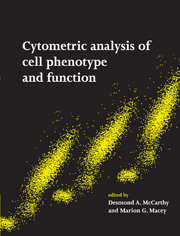Book contents
- Frontmatter
- Contents
- List of contributors
- List of abbreviations
- 1 Principles of flow cytometry
- 2 Introduction to the general principles of sample preparation
- 3 Fluorescence and fluorochromes
- 4 Quality control in flow cytometry
- 5 Data analysis in flow cytometry
- 6 Laser scanning cytometry: application to the immunophenotyping of hematological malignancies
- 7 Leukocyte immunobiology
- 8 Immunophenotypic analysis of leukocytes in disease
- 9 Analysis and isolation of minor cell populations
- 10 Cell cycle, DNA and DNA ploidy analysis
- 11 Cell viability, necrosis and apoptosis
- 12 Phagocyte biology and function
- 13 Intracellular measures of signalling pathways
- 14 Cell–cell interactions
- 15 Nucleic acids
- 16 Microbial infections
- 17 Leucocyte cell surface antigens
- 18 Recent and future developments: conclusions
- Appendix
- Index
- Plate section
11 - Cell viability, necrosis and apoptosis
Published online by Cambridge University Press: 06 January 2010
- Frontmatter
- Contents
- List of contributors
- List of abbreviations
- 1 Principles of flow cytometry
- 2 Introduction to the general principles of sample preparation
- 3 Fluorescence and fluorochromes
- 4 Quality control in flow cytometry
- 5 Data analysis in flow cytometry
- 6 Laser scanning cytometry: application to the immunophenotyping of hematological malignancies
- 7 Leukocyte immunobiology
- 8 Immunophenotypic analysis of leukocytes in disease
- 9 Analysis and isolation of minor cell populations
- 10 Cell cycle, DNA and DNA ploidy analysis
- 11 Cell viability, necrosis and apoptosis
- 12 Phagocyte biology and function
- 13 Intracellular measures of signalling pathways
- 14 Cell–cell interactions
- 15 Nucleic acids
- 16 Microbial infections
- 17 Leucocyte cell surface antigens
- 18 Recent and future developments: conclusions
- Appendix
- Index
- Plate section
Summary
Introduction
The very existence of multicellular organisms is dependent upon a balance between life and death. Starting with fetal development, through to tissue and organ regeneration in adulthood, events are determined by the timely activation of proliferation, differentiation and cell death. To maintain tissue and organ homeostasis, proliferation must be countered by cell death. For decades the emphasis of research in cell biology lay with investigations into proliferative responses and differentiation, but the importance of cell death is now well established as an active cellular process.
Apoptosis
Apoptosis is a series of sequential events under genetic control resulting in cell death (Darzynkiewicz et al., 1998; Penninger and Kroemer, 1998). It is seen during fetal development (e.g. loss of interdigitating membranes and synaptogenesis in the nervous system), thymic selection to eliminate self-reactive lymphoid cells, elimination of cancer and virally infected cells, and in cell and tissue renewal in the bone marrow, gut and skin. Morphological changes associated with an apoptotic cell include cell and nuclear condensation, accumulation of chromatin around the inner nuclear envelope and segregation of nuclear and cytoplasmic material into membrane-bound apoptotic bodies. In vivo, cytoplasmic membrane changes during apoptosis lead to recognition of cells undergoing apoptosis, resulting in phagocytosis by surrounding cells. The bottom line is that large amounts of cell death can occur without the spillage of cellular contents into the cellular environment, thus avoiding the induction of inflammatory responses. Biochemically, apoptosis is epitomised by the loss of the inner mitochondrial membrane potential (Δψm) and release of cytochrome c into the cytosol. The apoptotic machinery, consisting of a cascade of cysteine proteases, or caspases, is then activated; this, in turn, triggers the cleavage of the inhibitor of the caspase-activated deoxyribonuclease.
Information
- Type
- Chapter
- Information
- Cytometric Analysis of Cell Phenotype and Function , pp. 193 - 203Publisher: Cambridge University PressPrint publication year: 2001
Accessibility standard: Unknown
Why this information is here
This section outlines the accessibility features of this content - including support for screen readers, full keyboard navigation and high-contrast display options. This may not be relevant for you.Accessibility Information
- 2
- Cited by
